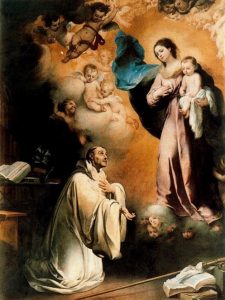 Saint Peter Nolasco
Saint Peter Nolasco
Feast Day –January 28
Founder, confessor (1189-1256)
Saint Peter Nolasco was born about the year 1189 at Mas-Saintes-Puelles near Carcassonne in France.
When he was a teenager he went to Barcelona to escape the heresy then rampant in southern France. He joined an army fighting the Moors in the Iberian Peninsula, which still held much of Spain in the early thirteenth century, and in sudden raids from the sea they carried off thousands of Christians, holding them as slaves in Granada and in their citadels along the African coast. He was later appointed tutor to the young king, James I of Aragon.
After making a pilgrimage to Our Lady of Montserrat at the Santa Maria de Montserrat monastery on the Montserrat Mountain in Catalonia, Spain, he began to practice various works of charity. Nolasco became concerned with the plight of Christians captured in Moorish raids, he consecrated the fortune he had inherited to the redemption of the captives taken on the seas by the Saracens. He was obsessed with the thought of their suffering, and desired to sell his own person to deliver his brethren and take their chains upon himself. God made it known to him how agreeable that desire was to Him. Because of these large sums of money he expended, Peter became penniless. He was without resources and powerless, when the Blessed Virgin appeared to him and said to him: Find for Me other men like yourself, an army of brave, generous, unselfish men, and send them into the lands where the children of the Faith are suffering. Peter went at once to Saint Raymond of Pennafort, his confessor, who had had a similar revelation and used his influence with King James I of Aragon and with Berengarius, Archbishop of Barcelona, to obtain approbation and support for the new community. On August 10, 1218, Peter and two companions were received as the first members of the congregation of men that became the Royal and Military Order of Our Lady of Mercy of the Redemption of the Captives (the Mercedarians). They were approved by Pope Gregory IX in 1230, and were also known as the Order of Our Lady of Ransom, dedicated to the recovery of Christian captives. To the three traditional vows of religion, its members joined a fourth, that of delivering their own persons to the overlords, if necessary, to ransom Christians.
The Order spread rapidly. Peter and his comrades traveled throughout Christian Spain, recruiting new members and collecting funds to purchase the captives. Then they began negotiations with the slave-owners. They penetrated Andalusia, crossed the sea to Tunis and Morocco, and brought home cargo after cargo of Christians. Peter governed his Order for thirty years, within which time he opened their prison doors to thousands of captives, whom his own incessant labors, joined with those of his disciples, rescued from a miserable fate, and, in all probability, from eternal death. Although Peter, as General of the Order, was occupied with its organization and administration, he made two trips to Africa where, besides liberating captives, he converted many Moors.
St. Peter Nolasco built in Spain the church of St. Mary del Puche. For four Saturdays, seven strange lights were seen at night over a certain spot, and looked like seven stars. They were observed to drop from heaven seven times, and disappear in the earth in the same place. St. Peter Nolasco felt certain that this strange phenomenon announced something; so he commanded men to dig about the spot. They had not gone far into the earth, when they came upon a clock of prodigious size, bearing a beautiful image of the Virgin Mary. Nolasco took it up in his arms as a valuable gift from heaven, and built an altar on the spot where it was buried. This altar became very celebrated for the number of miracles performed there.
Before his death, he called his children to his bedside, and exhorted them to perseverance in their love for captives. His words to them were those of the Psalmist: “I will praise Thee, O Lord, who hast sent redemption to Thy people!”
He had long and ardently cherished the desire of visiting the tomb of his patron, the Prince of the Apostles, whose name he bore, and was saddened at not finding an opportunity to execute this project. But now this holy Apostle appeared to him and addressed him: “Not all of our pious desires can be fulfilled. God is, however, satisfied with the intention. I know your longing to visit me at Rome; but such is not the good pleasure of the Lord. Yet, because you cannot visit me, I have now come to see you, and to assure you of my assistance till your last breath.” St. Peter Nolasco obtained a similar favor from his Guardian Angel and other Saints, who visibly appeared to him, no doubt to reward his special devotion to them. But Mary, the Queen of all Saints, gave him special proofs of her love and esteem. He saw her in person several times, and was filled with such sweet joy and consolation at her promise always to befriend him, that he cried out ecstatically at his last hour: “O how sweet it is to die under the protection of Mary.” He died after a long illness on Christmas night of 1256; he was canonized by Pope Urban VIII in 1628. His Order continues its religious services, now devoted to preaching and hospital service.
References and Excerpts
[1] J. G. Shea, Little Pictorial Lives of the Saints, a compilation based on Butler’s Lives of the Saints and other sources, New York: Benziger Brothers, 1894.
[2] “Saint Peter Nolasco, Confessor,” Catholic Harbor of Faith and Morals, [Online]. Available: http://catholicharboroffaithandmorals.com/Saint%20Peter%20Nolasco.html. [Accessed 28 December 2016].
[3] “Peter Nolasco,” Wikipedia, [Online]. Available: https://en.wikipedia.org/wiki/Peter_Nolasco. [Accessed 28 December 2016].
[4] “Saint Peter Nolasco – Lives of the Saints,” Magnificat, 24 February 2016. [Online]. Available: http://sanctoral.com/en/saints/saint_peter_nolasco.html. [Accessed 28 December 2016].